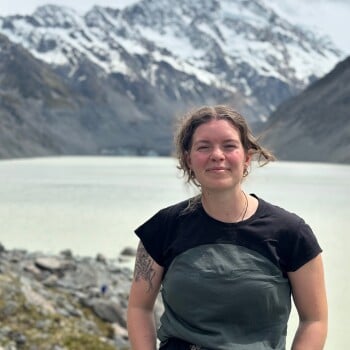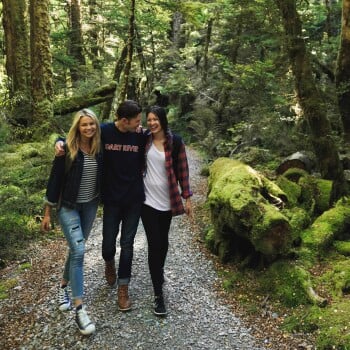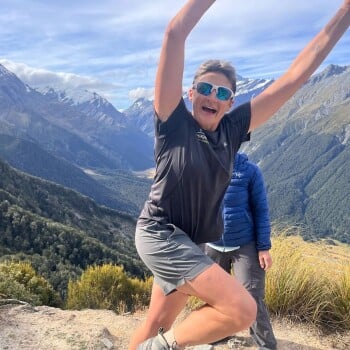- About Us
-
Trips
-
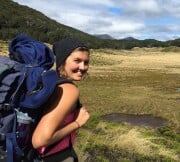 Kiwi-Style Hiking
Kiwi-Style Hiking
-
 Great Walks
Great Walks
-
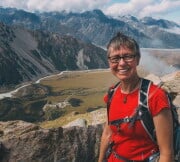 Hiking Tours
Hiking Tours
-
Alpine Hikes
-
Custom Groups
- Huayhuash Trek
- Family Northern Explorer
- Family Southern Explorer
- Lake Waikaremoana Hike
- Women's Custom Tours
- Women's Southern Wilderness
- Coast, Canyons and Mountains
- Coastal Wanderer Custom Tour
- Don't Cross the Ladies
- Secret South Custom Tour
- Tekapo Hike
- West Coast Custom Tour
- World Heritage Custom Tour
-
- Blog
- Shortlist
- About Us
- Trips
- Blog
- Shortlist

Feb 26, 2013
Mongolia was everything Daniel hoped it would be. For two weeks he did not see any other tourists, the scenery was dramatic and his taste buds were challenged! Read about Daniel's journey to Mongolia in 2012 and you too may be joining him on the Mongolia Altai Mountains Expedition in 2017.
Dinner Time
I gently prised the eyeball from its socket with my fork, but it comes out surprisingly easy thanks to the slow cooking process. Buoyed on by the encouragement (or mocking) of my fellow trekkers I decided not to make eye contact with the eyeball and get it straight into my mouth. Initial impressions are reminiscent of the classic Sunday roast, but as I begin to chew I soon realise that the eye ball is all about the texture. There is no unpleasant rubbery or sinewy feel to it all, as one might expect with an eyeball, but just a deliciously tender bordering on slightly mushy feel to as it goes smoothly down. The flavour is mild, and I can detect the earthy tones of the root vegetables it was cooked with. There was a wee bit of stringiness toward the end of this unique gustation experience, but I suspect that was the retina putting up a final fight. I was later told by Kushard (our translator) you can eat the whole eyeball (sheep), except the retina!
|
Mongolian cuisine critic, Dan Murphy, - sampling the eyeball |
This was just one of many "first experiences" during my recent trip to Mongolia. And while Mongolia might never make it to "cuisine" destination it more than makes up for it in other ways!
In August of 2012 I spent about two weeks trekking in the Altai Mountains in the West of Mongolia. Mongolia had long been on my bucket list, images of large unpopulated land, horses galloping across vast steppes and mountains and nomads living a lifestyle that has seen little change over centuries. Not to mention Genghis Khan and all the images that conjures.
After a day or so in the capital Ulaan Bataar, and joining up with the rest of the group (ten of us in total plus guide) we took a 3 hour flight to the town of Ulgii, John, our guide informed me to drive this section takes about 5 days or 30 hours if you drive constantly. Looking out the window of the plane you can see why, a road in these parts is no more than just a couple of rutted wheel tracks across the steppe. No wonder the horse is still a common mode of transport in Mongolia. From Ulgii, a 4 hour ride in a sturdy Russian 'Furgon' gets us to the village of Altai. Here we assemble gear, food, tack and horses and prepare for our trek. The plan is to spend the next 13 days riding, firstly through the broad open valleys and then cross a pass into Altai Tavan Bogd National Park.
Into the great wide open...
| "The Ger" - the hub of family life in rural Mongolia |
Riding out from Altai village the next morning, the vista is one of high craggy mountains, wide expansive valley floors with lush green grass growing near the bubbling crystal clear streams. The sky is blue and huge! It's summer time in Mongolia so local families make the most of the relatively short growing season and move with their animals (the five snouts) around the countryside and into the mountains - where ever there is grass. The five snouts comprise of the sheep, goat, yak, camel and horse. All animals are multi-use; meat, milk, fibre and in the case of the horse, and the camel they can be also be used as transport. Ger (yurt) camps dot the horizon, there is something very serene about the sight of the Gers. They symbolise shelter from the elements, places of warmth and nourishment. Where several generations of families live and work together in this vast and unforgiving landscape. In fact it's the sight of the Gers, that quintessential Central Asian look that reminds me that I am travelling and somewhere exotic!
Mare's milk and donuts at the Ger
| "High tea" Mongolian style |
| Our trusty wranglers |
Just before reaching camp on the first day we ride down a steep track into a sheltered basin where there is a Ger camp. This is Khatran's, our head wranglers patch, we dismount from our horses and tie them up to any suitable looking rock we can find. A couple of young boys drift over nodding politely and check out our horses like boys in other countries might check out a motorbike or a BMX. Khatran waves us over toward the central Ger, we head inside a little tentatively. Only vaguely aware of local protocols and customs, I initially feel a little awkward as I and my ten or so trekking companions descend on these peoples home. However, we are quickly made to feel at home and seated on soft cushions and felted rugs. The walls of the Ger are decorated with rich tapestries made by generations of family members. A wood burning stove sits in the centre and heats a huge tea pot. The Ger is warm and sounds from outside are muffled, it's a great place to relax after the first day in the saddle. It is customary in the countryside of Mongolia to invite in and feed any visitors. No doubt this is a custom borne out of necessity, as travelling through these parts in days gone by, the remoteness and extremes of climate, one might not have known when or where thier next meal would come! We are given fermented mares milk, known as airag. I have heard about this, while it is supposed to be very nourishing, it is much higher in lactose than cow's milk. The fermenting process lowers the lactose content to make it easier to digest. But to the average western gut used to cow's milk even the fermented mares milk can have quite a laxative effect. Not wanting to turn down the opportunity of trying something new, I decide moderation is the key. The airag is served cold and has a flavour similar to natural unsweetened yoghurt, slightly sour but quite refreshing. Khatrans wife invites us to try more of the large amount of food on offer, clotted cream, dried yak yoghurt and balzak - which is like a donut. It is all very good, and we leave not only with full bellies but enlightened from our first real taste of local life and visit inside a Ger. Our sure footed horses pick their way down a steep rock track to a river which we cross. Our support crew are already there setting up tents and getting a fire going for dinner. Despite some of the stories I heard about the food in Mongolia, our food so far has been great. Dinner tonight is a mild curry with lamb and lots of vegetables, there is a vegetarian on board and she is served up an equally appetising vegetarian curry. Weary from a day in the outdoors we all sleep well. Getting up in the night, I marvel at the stars, coming from New Zealand I am used to clear starry skies, but the complete lack of light pollution and dry climate here make the night sky superb.
No mans land
The next day we leave the valley and Ger camps and nomads behind and ride over a pass in to Altai Tavan Bogd National Park. The terrain is much more mountainous and Larch forests cloak the hillsides. During lunch the crew give us an impromptu show of Kazakh dance and song. It's pretty good, one of the wranglers (Bekan) plays the Dombra, which is similar to a mandolin and he is also a very good singer. Late afternoon we reach our campsite at the junction of two rivers, a beautiful setting, lush meadows surrounded by big mountains. However there is a storm brewing and we hurriedly set up tents, it seems as I am just putting the last peg in when the hail stones start to come down and thunder claps in the valley. Scurrying into my tent, I spend the next half hour listening to one of the most awesome thunder storms I have ever heard. Hail pelts the tent and the sky seems to be constantly rumbling and flashing with lightning. I feel sorry for the horses, but when I peek out they seem ok, heads down and backing into the driving hail. But as quickly as it comes it seems to pass over, and everyone emerges from their tents. During this time our trusty cook Soggy and guide Armongol have been huddled under a tarp cooking our dinner over the fire!
Crossing into the Autonomous Zone on day 3, we have our passports checked. Mongolia has a strip of land with restricted access on its Chinese border. We are fortunate that Armongol knows all the right people here, (she seems to have a lot of brothers) and we are waved through with a smile from the border guards. The horse mounted border guards here do regular patrols, mainly watching for poachers or illegal logging operations. But it seems to be a pretty laid back place.
Life at base camp
The base camp Ger is erected today, and we are hit by another hailstorm, but thankfully it passes quickly and we are soon lounging around in the Ger sipping tea. Two nights are spent at the Ger before loading up the pack horses and venturing up the valley. We establish another base camp in a grassy meadow, mountains on one side and fast flowing river on the other. I spend the afternoon picking wild currants and raspberries which are amazingly sweet, I also spot some wild garlic and rhubarb. The next day finds us high on the ridge with huge views of an extremely mountainous landscape, China is very close, just across the valley in fact. We are surprised to come across some horse mounted border guards, but not as surprised as they are to see a group of foreigners. It turns out they are looking for horses they have lost - that seems to be the standard answer if you run into anyone out in these remote parts! We have had a big day by the time we head back to camp, and on the descent a Bull Elk is spotted grazing the bush edge on the other side of the valley just on dusk.
The next day finds us back at the base Ger, the plan is to start heading out of the valley tomorrow and make another camp not far from the "Pass of Death" that we have all heard so much about! The climb up towards the pass takes us up towards a craggy range the locals refer to as the 'eagles nest'. It's noticeably colder up here and as evening sets in we are all putting on our spare layers. Just before dark I spot another Bull Elk grazing in the scrub, but it's not long before he disappears from view into the low growing scrub, herds of ibex also roam these mountains and we were fortunate to see a mob of twenty the previous day. As far as bears go though I have only seen the footprints and the poo! The wolves and the snow leopards have remained their characteristic elusive selves.
| On the descent from the "Pass of Death" |
The Pass of Death
By late morning the next day we are on the Pass of Death surveying the line to take on descent. It's steep and spectacular, but relatively straight forward, and it's not long before we are at the bottom, relaxing in the sun among some alpine tarns. Heading down the valley after lunch it suddenly feels like we are back in civilization, relatively speaking anyway. Gers dot the valley and herds of sheep, goats and yaks graze the hillsides. We tie up our horses outside a Ger camp in the mid afternoon, and are once again invited in for tea and a delicious array of homemade foods. Fox, wolverine and wolf furs adorn the sides of the Ger along with an ornately decorated bed that looks fit for royalty! After tea we are shown outside to an eagle that is tethered to a post and is being trained to hunt on command. Hunting with Eagles is quite a popular past-time in these parts, and festivals are held in the towns, where people travel from miles around to show off their eagles.
Haymaking Mongolian style

We say our goodbyes to the local family, thanking them for their great hospitality. The final three days of the trek are spent riding over into a neighbouring valley known as Shar Gol. The local families are busy harvesting the grass to be dried for winter feed. This is haymaking Mongolian style, scythes are used to cut the grass, it is then loaded on to trucks and stored in the winter camps, where it can dry, before being fed out in the winter. We all have a go at scything, but none of us manage to do it with the grace or efficiency of the locals!
| Scything -Khatran shows us how it should be done |
One for the road...
Arriving back in Altai village 13 days after we set off, it's a slightly more weathered, weary and possibly wise looking bunch than the one that set off two weeks ago. Some of the group are ready to go round again, some are just relieved to have stayed on the right side of their horse, although there was a couple of unplanned dismounts it was nothing some pain killers couldn't fix and as always, it wasn't the horses fault! We assemble gear, say our farewells to the horses and the wranglers that have looked after us so well. After a quick lunch Khatran pours us all a vodka for good health and the rest of the journey. Its good stuff and costs about the same as a bottle of water at home! On the road back to Ulgii our drivers expertly navigate their jeeps around the potholes and ruts and play Mongolian rock music. Our driver ingeniously stores his used chewing gum behind his ear, I presume to pull off to chew at some later stage.
We have been invited to spend the night in the house of Kushard's parents in law. Once again it's great to have the privilege of being invited into people's homes. They make us feel very welcome, and a great night is had. We are in party mode after two weeks in the hills, but we all seem to fade out pretty quickly after dinner, bellies full, and a vodka or two to put us to sleep.
|
Silly hats and rounds of vodkas - it's been a great trip!
|
The next morning we have time to explore Ulgii, markets and the museum before flying back to Ulaan Battaar.
It's been a great trip. Mongolia was everything I hoped it would be. For two weeks we did not see any other tourists. The local people we met were always friendly and somewhat surprised/confused to see us. Not once was I hassled into buying something nor did I have flocks of children hanging around begging for money or other goods. After two weeks of riding, I really feel like I have only scratched the surface of one small part of Mongolia, the scale of the landscape and the emptiness will leave lasting impressions. If Mongolia is on your bucket list - make sure you don't put it off too long. If it's not on your bucket list - add it now. Join me on the next Mongolia Altai Mountains Expedition.



